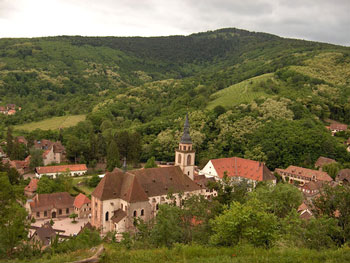In spring, the villages of Alsace, in the northeast corner of France, compete to see who can out-flower the other. A sign at the entrance to the village will tell you how many flowers (like stars, one to five) the village received in the contest. Competition is fierce – fiercely floral.
 As you drive along the Route des Vins from Strassbourg in the north to Colmar about midway south, there is a lot to see and taste. Wine tastings (degustations) are free and plentiful, so don’t be shy. My experience has been that the vintners are happy to see you. If you’re driving, you might want to wait until you’ve parked the car for the day. In Alsace, with its over 37,000 acres of vineyards, there’s a tasting waiting behind almost every door.
As you drive along the Route des Vins from Strassbourg in the north to Colmar about midway south, there is a lot to see and taste. Wine tastings (degustations) are free and plentiful, so don’t be shy. My experience has been that the vintners are happy to see you. If you’re driving, you might want to wait until you’ve parked the car for the day. In Alsace, with its over 37,000 acres of vineyards, there’s a tasting waiting behind almost every door.
The region is not only known for its extremely conservative politicians; Alsace is also famous for producing world-class Gewurztraminer, a spicy, honey-gold wine with a dry finish. Don’t call it sweet; you might get a slap in the face. Bad Gewurztraminer is sweet; the good stuff has been fully fermented to be dry. It’s much more complex – like a voluptuous woman with a dry sense of humor.
Start your tasting with a light wine like a Sylvaner or a Pinot blanc – or even a Muscat, which in Alsace is a dry, floral wine. Then move on to the Rieslings and then to the bigger varietals: the Pinot Gris (formerly known as Tokay Pinot Gris), our full-figured friend the Gewurztraminer, and then finally a Pinot noir, which in Alsace is a rosé and the only red varietal approved in the region.
In a town like Riquewihr, you’ll have dozens of chances to stop and taste the grapes, but the best place is at the top of the village near the tower. On the way up the main street, make sure you take the freshly baked macaroon being proffered to you (read shoved into your hand like a free sample of cocaine). The addictive coconut aroma in the village is coming from this bakery. Once you reach the tower at the top of the village, you’ll see a wine shop. The woman at Bernard Schwach who conducts the tasting – a voluptuous sweetheart herself in traditional Alsatian dress – must be the nicest person in Alsace. The tasting room is intimate – OK, cramped – but it’s worth it. This radiant woman will lead you through an enjoyable, informative tasting.
Emile Beyer in Eguisheim – or any member of his family – will also be glad to see you. This hard-working family has been producing wine in Alsace for hundreds of years. Their house is right on the main square in Eguisheim. For the tasting, go around back to the rustic courtyard and cough or sing or yoddel. You get the idea. Make your presence known, and someone will appear out of the flowers to pour you some wine. The Beyers don’t serve food, but there’s a butcher’s on the square where you can get paté and bread.
Hotels in Alsace are surprisingly affordable compared to hotels in larger cities. I’ve stayed in several of the villages – Riquewihr, Ribeauvillé, Ammerschwihr, and my favorite, Eguisheim. As you drive into this wheel-like Roman village from the south, you’ll end up on the main street quickly. The Hostellerie Du Pape, immediately on your right, offers comfortable rooms and the best sauerkraut garnished with potatoes and pork in its many varieties (choucroute garni) in town. A few years ago, in Eguisheim with a friend, we stayed in this hotel. Our friend’s room was just a few feet from the beautiful terrace where we dined (and wined) that evening—which was very fortunate for him.
A trip to Alsace is like a journey into a Brothers Grimm fairy tale, which can you reach in just a few hours from Munich, Frankfurt or Paris.
Photo by John & Mel Kots on Flickr